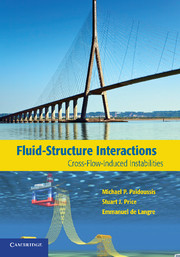Book contents
- Frontmatter
- Contents
- Preface
- 1 Introduction
- 2 Prisms in Cross-Flow – Galloping
- 3 Vortex-Induced Vibrations
- 4 Wake-Induced Instabilities of Pairs and Small Groups of Cylinders
- 5 Fluidelastic Instabilities in Cylinder Arrays
- 6 Ovalling Instabilities of Shells in Cross-Flow
- 7 Rain-and-Wind-Induced Vibrations
- Epilogue
- Appendix A The Multiple Scales Method
- Appendix B Measurement of Modal Damping for the Shells Used in Ovalling Experiments
- References
- Index
Epilogue
Published online by Cambridge University Press: 04 February 2011
- Frontmatter
- Contents
- Preface
- 1 Introduction
- 2 Prisms in Cross-Flow – Galloping
- 3 Vortex-Induced Vibrations
- 4 Wake-Induced Instabilities of Pairs and Small Groups of Cylinders
- 5 Fluidelastic Instabilities in Cylinder Arrays
- 6 Ovalling Instabilities of Shells in Cross-Flow
- 7 Rain-and-Wind-Induced Vibrations
- Epilogue
- Appendix A The Multiple Scales Method
- Appendix B Measurement of Modal Damping for the Shells Used in Ovalling Experiments
- References
- Index
Summary
Here are some closing remarks on the topics covered, some on what is not covered and some on what remains to be done to reach “perfect understanding”, fully realizing, of course, that this is an unattainable goal.
Transverse galloping may be said to be well understood and that it can be well predicted. The same cannot be said of torsional galloping or of mixed transversetorsional galloping/flutter, e.g. of bridge decks, or in situations involving substantial intertwining with vortex shedding. In this regard, the advent of models based on measured force and moment coefficients as in aeroelasticity has resulted in adequate predictive ability. However, this has had a deterious effect on the desire for enhanced physical understanding and on the funding opportunities towards achieving it.
Vortex-induced vibrations under lock-in conditions have received a great deal of attention over the years. Although understanding and modelling such vibrations has come a long way over the years, including the past decade, we still have a lot of ground to cover. Indeed, predictive tools are largely semi-empirical or they depend on CFD (which bypasses the need to understand physically). Thus, a great deal remains to be done.
Motivated in the 1970s and 1980s by wind-induced vibration problems on overhead transmission lines, and more recently by current-induced instabilities on offshore structures, wake-induced flutter of small groups of cylinders has received considerable attention.
- Type
- Chapter
- Information
- Fluid-Structure InteractionsCross-Flow-Induced Instabilities, pp. 357 - 358Publisher: Cambridge University PressPrint publication year: 2010



